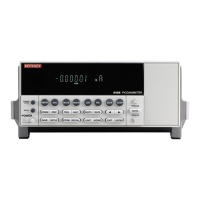Model 6485 Picoammeter Instruction Manual General Measurement Considerations C-5
Electrostatic interference is first recognizable when hand or body movements near the
experiment cause fluctuations in the reading. Pick-up from AC fields can also be detected
by observing the picoammeter analog output on an oscilloscope. Line frequency signals
on the output are an indication that electrostatic interference is present. Means of minimiz-
ing electrostatic interference include:
1. Shielding. Possibilities include: a shielded room, a shielded booth, shielding the
sensitive circuit, and using shielded cable. The shield should always be connected
to a solid connector that is connected to signal low. If circuit low is floated above
ground, observe safety precautions, and avoid touching the shield. Meshed screen
or loosely braided cable could be inadequate for high impedances, or in string
fields. Note, however, that shielding can increase capacitance in the measuring cir-
cuit, possibly slowing down response time.
2. Reduction of electrostatic fields. Moving power lines or other sources away from
the experiment reduces the amount of electrostatic interference seen in the mea-
surement.
Magnetic fields
A magnetic field passing through a loop in a test circuit will generate a magnetic EMF
(voltage) that is proportional to the strength of the field, the loop area, and the rate at
which these factors are changing. Magnetic fields can be minimized by following these
guidelines:
• Locate the test circuit as far away as possible from such magnetic field sources as
motors, transformers, and magnets.
• Avoid moving any part of the test circuit within the magnetic field.
• Minimize the loop area by keeping leads as short as possible and twisting them
together.
Electromagnetic Interference (EMI)
The electromagnetic interference characteristics of the Model 6485 comply with the elec-
tromagnetic compatibility (EMC) requirements of the European Union as denoted by the
CE mark. However, it is still possible for sensitive measurements to be affected by exter-
nal sources. In these instances, special precautions may be required in the measurement
setup.
Sources of EMI include:
• Radio and TV broadcast transmitters.
• Communications transmitters, including cellular phones and handheld radios.
• Devices incorporating microprocessors and high-speed digital circuits.
• Impulse sources as in the case of arcing in high-voltage environments.

